Climate Change Makes Things Harder for Unhoused Veterans
On a Friday afternoon in early September, the temperature stood at 94 degrees at Windsor Veterans Village just north of Santa Rosa, California—sweet relief from earlier in the week, when the mercury soared to 114 degrees. The sky looked hazy with smoke from the Mosquito Fire, which had already consumed tens of thousands of acres of forest in the eastern part of the state.
This particular fire burned more than 100 miles from Santa Rosa, a bucolic city in the heart of California’s wine country. But over the last five years, multiple wildfires have impacted Santa Rosa and the surrounding countryside. In 2017, a string of fires was estimated to have caused as much as $7 billion of damage in the city, destroying thousands of homes.
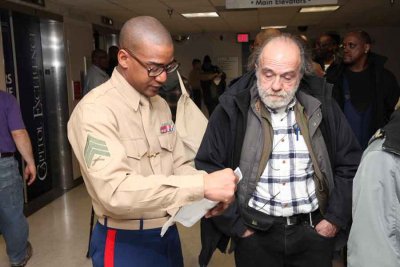
Marine Corps Sgt. David E. Martin assists a veteran during his visit to the Veterans Affairs Medical Center in Washington, D.C., in 2014, during an event for unhoused veterans. Photo by Sgt. Alvin Williams Jr., courtesy of the U.S. Marine Corps.
This pattern has played out across California—12 of the state’s 20 largest wildfires have burned in the last five years. While California has mismanaged its forests, which contributes to the increase in wildfires, researchers agree that rising global temperatures make fires both more frequent and harder to control. Thousands of Californians have evacuated their homes in recent years; many have been permanently displaced. Even in places untouched by fire itself, smoke and particulate matter choke out clean air.
“It’s scary. Scary. Very scary,” says Kenneth Gray, a Navy veteran at Windsor Veterans Village who has been without permanent shelter during previous wildfires. “You don’t know if you’re going to be running for your life or not. The only other experience I can relate that to is being on the flight deck of a carrier during flight ops.”
Windsor Veterans Village offers apartments to veterans experiencing homelessness. In 2020, more than a quarter of the country’s unhoused population—and more than 30% of all unhoused veterans—lived in California. Other states—like Texas, which in recent years has been battered by hurricanes, severe heat waves, and a historic deep freeze last winter—also have their share of unhoused veterans. As climate change wreaks havoc on the weather in these places, the effects on veterans and others living outside can be catastrophic.
“Disasters definitely have a disproportionate effect on those that are marginalized,” says Eric Samuels, who runs the Texas Homeless Network, which works to end homelessness in the state.
Extreme weather is on the rise around the world. While being displaced by a tornado or flooded out in a hurricane can be devastating for anyone, for those living without guaranteed shelter, these events can make daily life effectively impossible—and can delay access to needed resources and support.
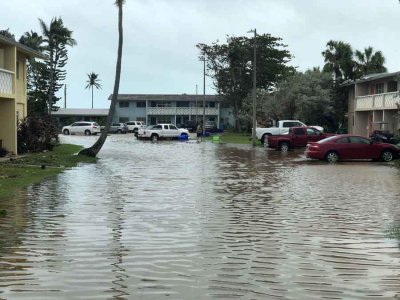
Hurricane Ian flooding hits Naval Air Station Key West on Sept. 28. Because of climate change, NASA says hurricanes will cause more rainfall and flooding in the future, as well as increasing in intensity. Increases in extreme weather events affect veterans dealing with homelessness because they have nowhere to store their belongings; because the systems they use are taxed by others in emergencies; and because as temperatures increase or decrease, shelter is harder to find. Photo by Mass Communication Specialist 2nd Class Nicholas V. Huynh, courtesy of the U.S. Navy.
Unhoused people often find themselves on the frontlines of the effects of fires, floods, and extreme temperatures as weather changes around the world. In recent years, damaging weather and related natural disasters have increased in both frequency and severity, driven by climate change. Hurricanes are getting stronger. Storms are dropping more rain. Sea level rise contributes to higher storm surges, increasing flooding. In the western part of the country, a “megadrought”—the worst in more than a thousand years—continues. The worsening California wildfire seasons have been spurred in part by rising temperatures.
Veterans are disproportionately represented among people experiencing homelessness, even after more than a decade of improvement. And while unhoused veterans may have access to resources that other people experiencing homelessness do not, they also tend to have more complex physical and mental health conditions that can make bouncing back from disaster even more difficult.
“Veterans are still coping with the aftermath of the fires,” says Mary Haynes, who leads the Northern California branch of Nation’s Finest, which runs Windsor Veterans Village. “For the unsheltered, it’s very, very difficult.”
‘It Would Be Considered a Mass Casualty Event’
In the United States, veterans make up about 7% of the population but 13% of people experiencing homelessness. That’s a drastic improvement from a decade ago. Concerted efforts to identify and house veterans have cut veteran homelessness by more than half in the last 12 years. But the pandemic and high rates of inflation have increased economic insecurity, and even veterans with housing can be at risk of homelessness: Nearly 13% of housed veterans report income at or below 150% of the poverty line. According to research by the Bob Woodruff Foundation, half of all veterans between the ages of 25 and 54 say they have less than $4,000 in their bank account.
Veterans are overrepresented among the homeless population for a number of reasons, says Blake Harris, who runs the mental health department for the Texas Veterans Commission. Veterans may be more likely to experience trauma, which correlates with homelessness. And they have higher rates of traumatic brain injuries, which can be a risk factor. Veterans experiencing homelessness also tend to be older, Harris says.
“They may have fewer supports in terms of family and friends and other folks that can also lend a hand,” Harris says. “They also have barriers to being employed. The kind of overarching thing is the amplification of all the risk factors that are there for your general civilian unsheltered person.”
In general, unhoused people receive less health care than housed people. While people living outside struggle with many of the same ailments as the overall population, those problems are often worse, says Tipu Khan, a physician who works with unhoused people in Southern California.
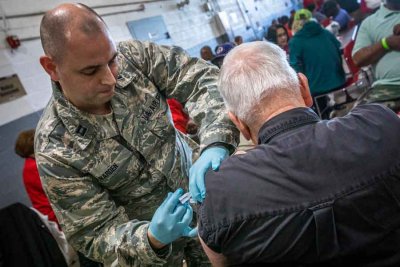
U.S. Air Force Capt. Kerwin Barden, chief nurse, 177th Fighter Wing, New Jersey Air National Guard, gives an unhoused veteran a flu shot in Cherry Hill, New Jersey, in 2019. Extreme weather events can tax the systems veterans without housing depend on for health care, shelter, and food. Photo by Mark C. Olsen, courtesy of the New Jersey National Guard.
“Some of the bread-and-butter stuff is still an issue,” Khan says, pointing to chronic conditions like diabetes and high blood pressure. “What I think tend to be more prominent in this population is those issues tend to be a little bit more uncontrolled. So we tend to see more complications of the diabetes, of the high blood pressure, because they don’t have access to regular care.”
In severe heat, like parts of this summer when more than half the U.S. population was under a heat warning or advisory, unhoused people face higher rates of heatstroke and kidney failure—severe dehydration can lead to decreased kidney function. Heat and fatigue exacerbate chronic conditions, and heat-related deaths have risen in recent years in the United States. In 2021, in Maricopa County, Arizona, where temperatures often reach into the triple digits, 130 unhoused people died from heat-related causes—about double the number who died in 2019.
“If 130 homeless people were dying in any other way, it would be considered a mass casualty event,” Kristie Ebi, a professor of global health at the University of Washington, told The Associated Press.
Similarly, in extreme cold—such as the winter storms that swept across Texas in February 2021, pushing temperatures to single digits in some parts of the state—unsheltered people can bear the brunt of the chill. Across the state, at least 246 people died because of the storms, most of them from exposure.
Homelessness is worsening in the United States, and severe weather affects everyone without stable housing. But veterans provide a microcosm for looking at the crisis—and is a population that can be particularly impacted by these weather events. Disasters and severe weather events can retraumatize some veterans. Harris has worked with veterans who served in the Middle East who struggle during heat waves.
Award-Winning Journalism in Your Inbox
“We’ve had some experience working with veterans that will say, ‘You know it’s really hot out there,’” Harris says. “It can kind of bring them back to some of the experiences they may have gone through in the desert. So it can be triggering in and of itself.”
Veterans may also be more reluctant to accept help or move into shelters, even during emergencies. “They don’t trust the system often, because the system has failed them,” Khan says. “So when they hear, ‘Hey, we’re with the county hospital,’ I think that’s a turn-off, initially.”
Even absent those additional factors, moving inside to safety, when possible, may be more difficult for unhoused people than for those with houses. People who live outside often rely on pets for protection and companionship, but many homeless shelters don’t accept animals. And leaving behind belongings can be devastating and destabilizing. When an evacuation order comes down, people who live inside can often pack some essentials to take with them when they go—leaving the rest of their belongings inside their homes and hoping for the best. People experiencing homelessness, by contrast, typically do not have a safe place to leave their belongings, and taking everything with them to a shelter often isn’t an option.
“They’re carrying everything valuable to them with them,” Harris says. “So a lot of folks are almost root-bound to the spots that they find, where all their stuff is with them. … How do you pack up your entire life and take it with you?”
‘It Multiplies Everything by a Factor of a Thousand’
In 2017, when Hurricane Harvey made landfall in Texas as a Category 4 storm, it dropped more than four feet of rain in parts of the state and spawned dozens of tornadoes. About 32,000 people were displaced, and more than 210,000 people requested disaster assistance from the Federal Emergency Management Agency.
“When Harvey hit, we had thousands of people who were in shelters,” Samuels says. “They sent people to San Antonio, Dallas, Austin, Fort Worth. We even had some people go to Amarillo. So automatically, those agencies in those cities are doubled or tripled in terms of capacity.”
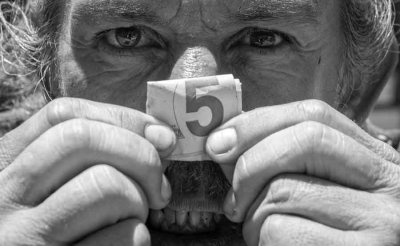
A homeless U.S. Army veteran shows a folded-up five-dollar bill prior to entering a convenience store in the Chinatown District of Honolulu, Hawaii, in 2016. Choosing to remain unnamed, he said he constantly relives the combat situations he endured during his time in Vietnam, and that he lives among dozens of other veterans who also experience many of the same psychological symptoms because of their time spent in the military. Photo by Tech. Sgt. Brandon Shapiro, courtesy of the U.S. Air Force.
During a natural disaster, the systems people experiencing homelessness rely on for services can be overloaded with an influx of people who previously did not need support. First responders, hospitals, shelters, and community organizations can be overwhelmed, leaving unhoused people with fewer places to turn for food, shelter, or medical care.
“Case managers are used to dealing with disasters,” Samuels says. “But these large-scale disasters that happen to multiple households and individuals—it just multiplies everything by a factor of a thousand.”
Organizations that serve homeless populations must prepare for worst-case scenarios, says June Gin, a Veterans Affairs researcher who studies disaster preparedness in homeless services organizations. When an emergency arises, local officials often offer guidance aimed at people with stable housing.
“Everybody tells us you have to have three days’ worth of food and water stored,” Gin says. “[Unhoused people] obviously can’t store anything, barely.”
Providers should also think through the situations that will be particularly hard for people living outside or in unstable situations. In California, for instance, frequent triple-digit heat waves and wildfires encroaching on urban areas pose newer threats.
“I would say the challenge is that maybe they haven’t always been recognized as disasters,” Gin says. “I think that there were a lot of people who sort of thought, Well, we’re preparing for earthquakes.”
In this case, unhoused veterans may have an advantage. VA-funded organizations that provide transitional housing for veterans must have updated disaster plans. And VA often has resources to support veterans after an emergency. “It’s great to have the VA in your corner,” Gin says. In fact, she says, disasters can provide an opportunity to connect veterans to resources or benefits they didn’t know about or have access to before an emergency.
But that cuts both ways, Harris says.
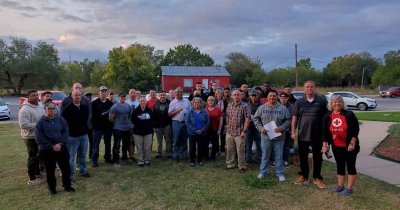
A group of volunteers gather to support the homeless veteran count in the Lawton-Fort Sill area in Oklahoma in 2021. The majority of volunteers were from the Non-Commissioned Officer Academy; 1st Battalion, 78th Field Artillery; and the Fort Sill Marine Detachment. Photo courtesy of the U.S. Army.
“There are a lot of resources for veterans through the VA, and then through state partners, and then through community organizations who are invested in serving those who have served,” he says. “However, there is also, at the same time, a misconception among many folks that, ‘Well, they’re taken care of by the VA,’ or, ‘The VA takes care of all their needs.’ And that’s not necessarily the case.”
Ultimately, stable housing for veterans provides the best long-term solution. At Windsor Veterans Village, Robert, a Navy veteran who lived outside for 27 years in Northern California before learning he qualified for an apartment last year, says living outside in extreme conditions is never easy.
Our Journalism Depends on Your Support
“It’s hard in the wintertime,” he says. “If you don’t have blankets, you can’t stay warm. Shower facilities are practically nonexistent.” During heat waves, following medical advice—stay hydrated, stay cool—isn’t necessarily possible. “There’s not always water available. There’s not always shade available. Especially in that kind of heat, because everybody’s running for shade.”
When the temperatures reached the triple digits earlier in the week, Robert says, for the first time, he was able to hunker down in his own space. His new place stays so cool that he turned on the air conditioning for only a couple of hours.
He spent the heat wave cleaning his apartment.
This War Horse feature was reported by Sonner Kehrt, edited by Kelly Kennedy, fact-checked by Ben Kalin, and copy-edited by Mitchell Hansen-Dewar. Headlines are by Abbie Bennett.





Comments are closed.